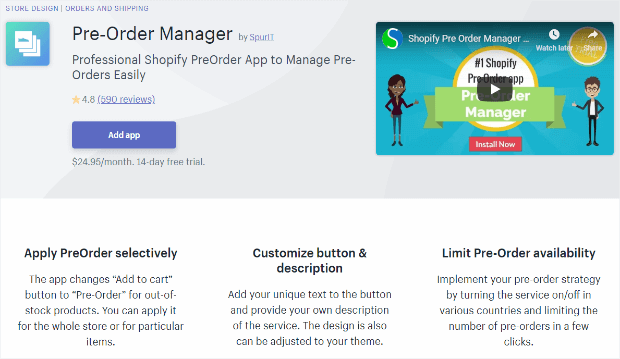
When it comes to pre-orders, shoppers are considering items that aren’t available yet. You’re almost ready to embark on the journey of Shopify pre-orders to generate more sales and buzz! Before you begin, here are some helpful tips:

Once you’ve captured a pre-order, you’ll see the details in either Shopify’s order management system or your app’s dashboard. Offer an analytics and management dashboard specifically for Shopify pre-orders The easiest way to implement Shopify pre-orders in your store is by downloading apps like Pre-Order Now or PreProduct to:Īutomatically replace your “Buy Now” or “Add To Cart” button with “Pre-Order” if a product is out of stockĪdd new context to your product pages on expected shipping dates Pre-Order Nowincludes tons of features that’ll make your pre-order campaign a raging success. This can add stress to your customer service channels - and even worse, damage your brand reputation. Remember: Poor communication about product updates or lead times can cause impatience and worry in shoppers, especially those who have paid upfront. With this type of pre-ordering, both you and your customer can cancel at any time.Ĭrowdfunding.Backers only receive items if the campaign’s pre-order goals are met. Pay Later.The shopper puts their name on the list (with the intention of paying when the product is available). If certain existing products are out of stock, but you have a definite date for when they’ll be restocked, pay now pre-orders can be an effective solution for keeping shoppers interested. Pay Now.This is just like a regular purchase, except customers won’t receive their products immediately. Types of Pre-Ordersĭepending on the nature of your business, there are different types of pre-orders that may work best for your brand: It’s also an excellent way for brands to maintain their cash flow and recoup sunk costs when dealing with supply chains, manufacturers, and shipping carriers. The last thing you want is to invest tens of thousands of dollars in developing a product that nobody wants - whether that’s due to changing trends or unforeseeable circumstances (like a pandemic).Ī pre-order campaign reduces that financial risk, serving as an invaluable way to validate a product idea. While you may not need to pay rent for a brick-and-mortar store as an ecommerce brand, there’s still significant risk and capital involved with selling and transporting physical goods. Pre-orders make sense for brands of all sizes. Think of Sony’s massivePlaystation 5 pre-sale campaign. It’ll also help eliminate overproduction.Īn established retailer can use pre-orders to generate hype. There are countless ways that brands use pre-orders to their advantage:Ī startup that needs more cash can create a Kickstarter or Indiegogo campaign to amass backers, even though the actual prototype or product may not be designed, manufactured, or shipped for months (or even years, in some cases!).Įver backed a Kickstarter campaign? Yup, that’s pre-ordering in action.Ī boutique business can use pre-orders to test and validate demand for a new product. Once the product is ready, it’s shipped straight to customers who pre-ordered, giving them an upper hand over the general public. Pre-orders allow customers (new and returning) to purchase an item that has yet to be released or is out of stock. It usually requires a mix of targeted marketing and word of mouth - but you can help accelerate it with one simple trick: Shopify Pre-orders. (Fun fact: Kylie Cosmetics is powered by Shopify.)No matter how excited your team is for a new product, hyping up shoppers is another beast to conquer. That’s how Kylie Jenner sells out of her lip kits in mere minutes.

Combining the feelings of anticipation and fear of missing out (FOMO), it’s one of the easiest ways to get shoppers to flock to stores and empty shelves.

Hype - it’s one of the most magical words in the ecommerce world.


 0 kommentar(er)
0 kommentar(er)
